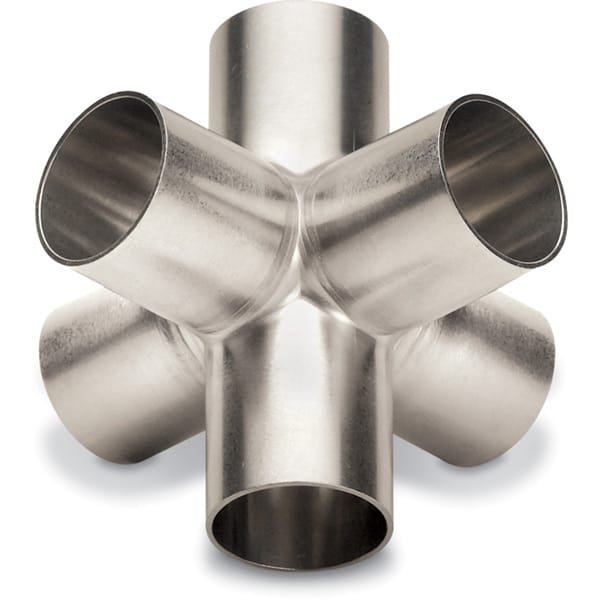Weldable Tube 6-Way Crosses for UHV and Semiconductor Applications
TFM’s Weldable Tube 6-Way Crosses are purpose-built components engineered for the most demanding ultra-high vacuum (UHV) environments and semiconductor processing infrastructure. Crafted from 304 series stainless steel using advanced fabrication methods, these six-way fittings offer unparalleled cleanliness, precision, and adaptability for high-performance vacuum systems.
Each 6-way cross is fabricated using the pulled-port technique, ensuring full-penetration butt welds for enhanced mechanical integrity and leak-tight performance. Designed specifically to meet UHV standards, these crosses deliver vacuum capability down to ≥ 1×10⁻¹³ Torr, ideal for critical applications in semiconductor subfabs, pump exhaust lines, and foreline vacuum plumbing.
The defining feature of the Weldable Tube 6-Way Cross is its multi-axis symmetry, offering six tube connections in perpendicular orientations. This makes it a superior choice for vacuum network hubs or distribution nodes where multiple gas or vacuum lines must converge with minimal contamination risk.
With a temperature tolerance ranging from –200°C to +450°C, these crosses are suitable for both cryogenic and high-temperature operations. Their crevice-free weld geometry ensures that no particle traps or contamination pockets exist, which is essential for high-purity process environments.
Key Features of Weldable Tube 6-Way Crosses:
Material: 304 Stainless Steel, ideal for semiconductor-grade UHV systems.
Six-Way Configuration: Offers connection points on all three Cartesian axes, enabling efficient system layouts.
Cleanroom-Ready: Cleaned and prepared for use in ultra-high vacuum environments exceeding 1×10⁻¹³ Torr.
Fabrication: Constructed via pulled-port method with full-penetration butt welds to eliminate internal crevices.
Temperature Range: Capable of withstanding thermal conditions between –200°C to +450°C.
Custom Configurations: TFM offers tailored tube diameters, wall thicknesses, and flanged variants upon request to meet your exact design requirements.
Applications Include:
Semiconductor foreline and exhaust systems
Gas distribution manifolds in vacuum deposition tools
Research-grade UHV chamber interfaces
Cryogenic and high-temperature vacuum processing lines
Critical vacuum junction hubs for multi-directional flow
Whether you’re constructing a new semiconductor-grade vacuum manifold or upgrading existing UHV tooling, TFM’s Weldable Tube 6-Way Crosses provide the strength, cleanliness, and reliability your system demands.
For engineering drawings, dimensions, or custom fabrication inquiries, please contact TFM’s support team for expert assistance.





Reviews
There are no reviews yet.